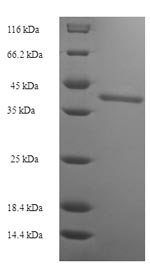The expression region of this recombinant Human SSX2 covers amino acids 1-188. The theoretical molecular weight of the SSX2 protein is 37.6 kDa. This SSX2 protein is produced using e.coli expression system. Fusion of the N-terminal 6xHis-SUMO tag into the SSX2 encoding gene fragment was conducted, allowing for easier detection and purification of the SSX2 protein in subsequent stages.
The human SSX2 protein functions in transcriptional regulation, playing a role in gene expression control. Understanding SSX2's functions enhances insights into cancer biology, gene regulation, and reproductive processes, offering potential applications in cancer diagnostics, therapy, and reproductive health research. In cancer research, SSX2 is associated with various malignancies, potentially contributing to tumor development. Its involvement in immunotherapy targets provides avenues for cancer treatment. In reproductive biology, SSX2 participates in spermatogenesis.




